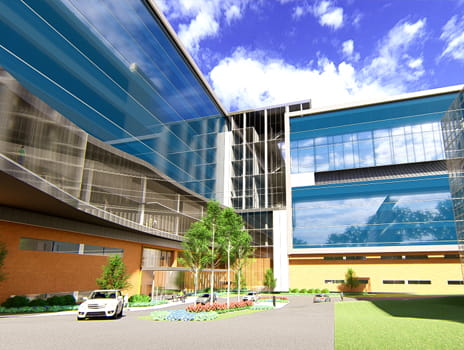- Home
- Research
- Research that Transforms
- Beyond the Bench
- Beyond the Bench 2020
- A Space for Team Science
A Space for Team Science

Leaders of The University of Kansas Cancer Center and Kansas City community are busy planning for a new cancer research facility that will bring scientists together under one roof. Currently, labs and researchers are scattered across the Kansas City metro area. The 438,000-square-foot building will unite people across all scientific disciplines, encouraging seamless collaboration.
Key attributes of the research facility will include centralized equipment and research core facilities; animal care and imaging facilities; patient exam and treatment areas; a clinical molecular oncology laboratory; an auditorium, incubator space and 58,000 new net square feet for future expansion.
We are also considering the inclusion of the cancer center’s Hematologic Malignancies and Cellular Therapeutics Division, led by Joseph McGuirk, DO. The future site of the facility — north of the Hemenway Life Sciences Innovation Center on the main KU Medical Center campus — is just a five-minute stroll from Cambridge Tower A, which is home to the cancer center’s blood and marrow transplant and cellular therapy care services. The two buildings will be connected via a pedestrian bridge.
“This state-of-the-art building will allow our scientists and clinical team members to work together in close proximity, creating a synergy that will result in the development of novel, more effective and less toxic therapeutic strategies to treat and cure cancers,” Dr. McGuirk said. “Such a unique environment, existent in few cancer centers nationally, will further facilitate our institutions’ recruitment of leading scientists and clinical researchers. Hopefully, we will be able to make this happen.”
The new facility also tackles a critique of the National Cancer Institute (NCI). Every five years, KU Cancer Center applies for NCI designation renewal. In the last renewal, site reviewers noted that geographic dispersion would need to be addressed to strengthen the cancer center’s bid for Comprehensive designation, the NCI’s premier ranking awarded to the very best cancer centers. Comprehensive cancer centers must demonstrate scientific excellence in transdisciplinary research. Not only will the new facility support a culture of collaboration, it will attract more physician-scientist recruits, broadening our portfolio of progressive clinical trials. For patients, this means access to more leading-edge, lifesaving treatments.
Still in the planning stages, cancer center director Roy Jensen, MD, and a core team comprised of community leaders and longtime cancer center supporters are mapping out a strategy to raise funds for the facility. Construction will take about three years.
“We need a space that supports our vision to conquer all cancers,” said Dr. Jensen. “The new facility will support true team science, allowing us to pool the expertise and resources of many. Research becomes transformative when we break down the silos and come together.”